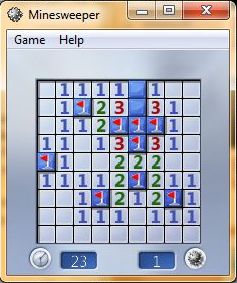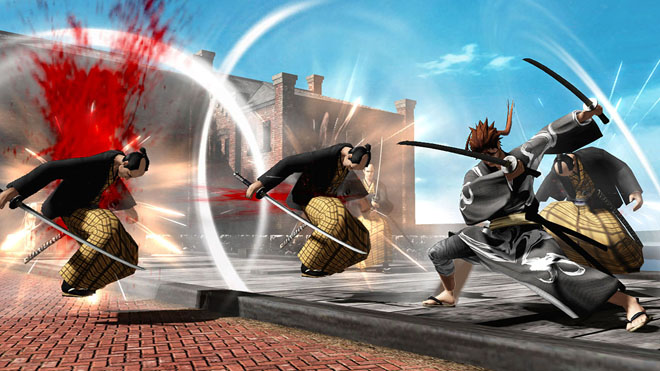Final Fantasy XIV: A Realm Reborn — I Spent How Long Playing One Game?!
(Note: this is a review of the PS3 version of the game. Certain features differ from one system to the next.)
One day in January, I thought, “Well… Final Fantasy XIV’s on PS3 now so I might as well at least try it.” I purchased the software, signed up for the free trial, played a bit, then looked up again and it was September. “What the… what year is it and why is my hair down to my knees?”
I’m just kidding, especially about the hair. In all seriousness, given how I like to generally finish with a game and move on to the next one in a reasonable time frame, the fact that I ended up playing this game for eight months must mean it’s at least somewhat good, right?
This is actually the 2.0 version of the game, titled A Realm Reborn. The original version was so terrible that Square-Enix decided they needed a do-over and actually made a new Final Fantasy XIV from scratch. This generally doesn’t happen in gaming, most MMOs that fail end up disappearing quietly, sometimes before they ever reach full retail release. When you have as much resources as Square-Enix does, and when the brand name has as much cachet as Final Fantasy does, any MMO in the series that doesn’t live up to expectations can be redone and/or fixed.
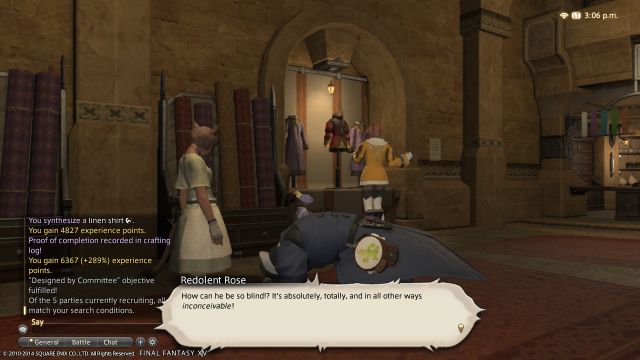
The story of A Realm Reborn begins at the end of 1.0’s story, during the final moments of the planet Hydaelyn’s Sixth Astral Era. The Carteneau Flats is the site of an epic battle between Eorzea and the Garlean Empire while the moon Dalamud draws ever nearer to the planet, threatening to wipe out all life a la Final Fantasy VII. But in an unexpected twist, Dalamud suddenly breaks apart, revealing that it was merely the cage for a beast named Bahamut and as the Light Warriors look on, Bahamut rains down destruction from the sky, laying waste to whatever it can. An effort is made to seal Bahamut again, presumably because his appearance near the end of a Final Fantasy is expected, yet this is also the beginning of the new version of Final Fantasy XIV and it wouldn’t do to have Bahamut already loose. However, the effort is shown to fail and as a last ditch effort, the Light Warriors are sent away, transported by magic…
It is the start of the Seventh Umbral Era. Five years have passed since the Battle of Carteneau, and Eorzea has been steadily rebuilding. Bahamut having finally been sealed off and the Garlean army temporarily turned away in defeat, the atmosphere is tense, the peace tenuous. New threats roam the world: a mysterious swordsman wielding an oriental sword, and a beast that calls the snowy lands to the north home. The Light Warriors suddenly reappear and to their delight, Eorzea still stands.
This is where you, the player, comes in. But before you can take your first steps (or your returning steps) in Eorzea, it’s character creation time (or, I assume, character import time)! Hand it to Square-Enix for creating one of the more comprehensive character creation modules I’ve ever seen, even better than Mass Effect and about on par with Guild Wars II. This game gave me the freedom to create almost exactly the character I wanted, so I translated a character I’ve had since 2003 into what would most likely be her Eorzean form. Thus the Miqo’te named Sara Tyger was born.
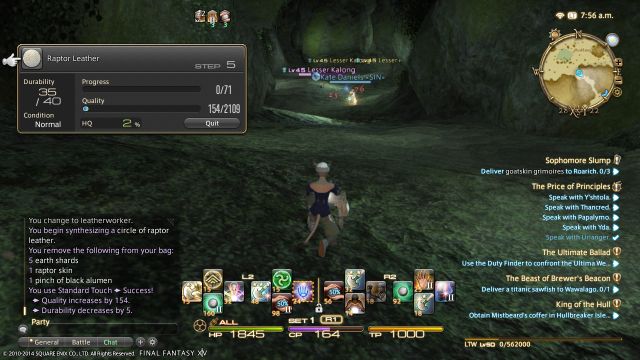
I had a tough time deciding what class to make Sara, but I shouldn’t have worried about it so much. One of the features unique to MMOs but not unique to Final Fantasy is that every character can be every class, so if someone’s in need of a healer for a low level dungeon, someone else needs a tank for a high level dungeon and a third person needs a DPS for one of the overworld fights known as FATEs, it’s possible for one character to fill all three needs. This is something that hearkens back to Final Fantasy III and was refined in the fifth game, in Tactics, and in the sequel to the tenth.
However, there are two things those older games had that’s missing from this one. First is the kind of freedom where you could make an entire team whatever classes you wanted. Oh, it’s still very possible to show up in a dungeon as a team of White Mages, like the infamous challenge from the first Final Fantasy, but it’s not recommended, especially not in the higher level dungeons, and very few players would be willing to try it. Then again, it’s not like dungeons require a specific party make-up other than the “holy trinity”. The other thing missing is the ability to cross-class all the skills learned. This wasn’t actually present in Final Fantasy X-2, nor in III, but V and Tactics contained the ability to do insane things like give a magic user lots of extra HP or grant magic spells to a Fighter. Instead, some skills can be used by other classes, but some can’t. Classes can also be combined into the more advanced jobs the series has made famous, like White Mage and Dragoon. These jobs bring with them higher stats, specialized abilities and iconic equipment only that job can equip.
The “holy trinity” I mentioned consists of a tank, someone whose main purpose is to take damage, a healer, someone whose main purpose is to heal damage and two DPS, people whose sole purpose is to damage enemies. That is what is considered a “light party”, whereas a “full party” is just double that. I like having four players in a dungeon because lately, Square-Enix has been downsizing their parties. It honestly felt like Final Fantasy XIII was a single character game with how fragile the universe got whenever Lightning The Load-bearer died.
The battle system itself is the natural progression of nearly thirty years of evolution. From the first turn-based menus to the faster-paced ATB system that revolutionized RPG battles to Final Fantasy XII’s Gambit system, Squaresoft and then later Square-Enix have been experimenting with ways to make battles feel more natural, more fast paced, more threatening. There’s nothing less frightening than looking at the next random battle and while the enemies are waiting to attack, thinking, “Okay, these imps are staring menacingly at me. Should I shoot fire at them? Wait, aren’t these ones allergic to ice? Also, I think their purple skin makes them immune to lightning. I think I’ll Alt+Tab over to Firefox and look this up.”
Anyway, instead of menus, players utilize hotbars like PC games have had for years. When L2 or R2 are held down, players have access to up to eight spells, skills and items, sixteen total per hotbar. A player can customize up to eight hotbars per class, and it’s a simple matter of using R1 to cycle though them.
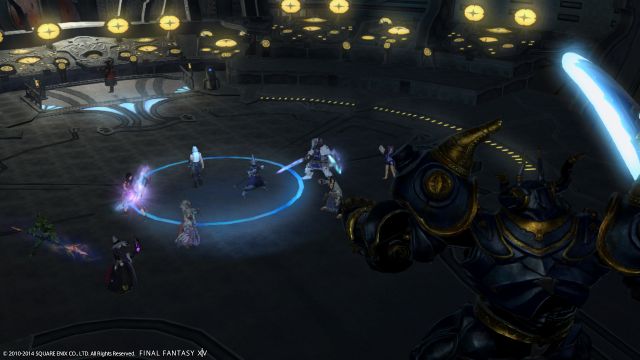
MMORPGs have a reputation for being incessant grindfests, where players are forced to kill the same thing for days at a time in order to reach the next power level, but modern MMO design eschews such notions in favour of a focus on end game content. It doesn’t take a lot of effort to reach the current maximum level in a class and finish the main story. Upon completion, a whole wealth of new content is available, including further chapters in the story that were added in some of the major content patches that have been provided for free by Square-Enix. There is also the option of levelling other classes, which many players choose to do.
All of this stuff can be done mostly solo with the exception of the dungeons. That’s what drew me to the game, I could get pretty far without having to go introduce myself to complete strangers and hope they’re willing to help me. Going into dungeons the first few times still made me extremely nervous, but thanks to the Duty Finder feature, which put me into the dungeon I wanted with other players who happened to be lining up to get into the dungeon at the same time, that passed with time and experience.
Experience points are given out very generously by the game for various accomplishments like fighting enemies, exploring the world map, completing dungeons and quests, even fulfilling entries in the Challenge Log, an arbitrary list of tasks reset weekly. Complete five dungeons, get rewarded. Find three treasure maps, get rewarded. Complete five, ten, fifteen and twenty entries in the Log, get further rewarded.
That’s basically Final Fantasy XIV’s design in a nutshell: all rewards, very little punishment. Death is a very minor slap on the wrist. Unlike other MMOs where death reduces your experience points, games like Diablo II where you have to rush back to where you died and pick up your equipment while dressed as a guy who just woke up in his undergarments or games like Dragon Quest where a hefty monetary penalty is incurred, the worst thing that happens to a character in this game is that their equipment loses a slight bit more endurance and must be repaired sooner. If a character is brought back by a Raise or a Resurrection spell, they also suffer from a few moments of weakness, which reduces their stats until the effect wears off.
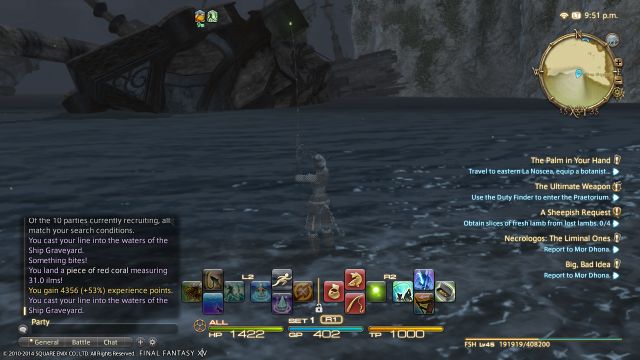
Adventurers who grow tired of killing things still have options. Multiple crafting and gathering classes exist in the game, all of which support each other, although keeping a handle on all the materials needed can be a strain on your personal inventory. Even with the two free retainers handling all your excess items (an additional charge to your monthly subscription can increase how many retainers are available), inventory management feels like a full time job. Although it’s a step backwards for Final Fantasy to have a limited inventory space, this is in keeping with MMO conventions; I’ve noticed other MMOs that I’ve tried also limit how much inventory you can carry.
Although gathering couldn’t be more simple (generally, if an item has been found once, it’s relatively easy to keep harvesting it), crafting is its own dynamic system and sometimes it feels like I’m doing battle with the game itself. In a good way, though, not a bad way. Recipes have a certain amount of durability and a certain amount of progress that needs to be accumulated in order to make the item. They also have a certain amount of quality that can be bestowed upon the item during crafting, and increases in quality grant a greater chance of crafting a high quality item. These high quality items can automatically add quality from the start when used to craft something else, and if a piece of equipment is high quality, its stats are greater than a normal piece. Consumable items are also more potent when they are high quality. Actions meant to increase progress and quality use up durability, so beginner crafters aren’t guaranteed to make high quality items every time, but expert crafters have it down to an exact science.
During my time in Eorzea, I was taken with how gorgeous everything is. Even though I was playing on a PS3, the graphics were still at least on par, if not better than Final Fantasy XIII’s graphics. It’s pretty, it sounds great, it plays well, and the biggest drawbacks I can think of are mostly player related. You may have noticed the new column pop up a few months ago, and I plan on continuing that as long as players – and gamers in general – still act stupid. But while I may be critical of some of the players of Final Fantasy XIV, the game itself is very good and should be judged on its merits, not the merits of its population. I am pleased to say, though, that the majority of players I ran into were very supportive and helpful.
I have only scratched the surface, though. There is a lot that this game has that I can’t really get into without adding at least another thousand words to the review. Free Companies (basically, this game’s version of guilds), in game achievements that grant prizes, chocobos, seasonal events, treasure hunts, PvP (although given the RPG battle system, PvP is still not perfect) raids, an extensive gear system… there is plenty to do in Eorzea, so it’s easy to see how one could spend months and months playing this game.
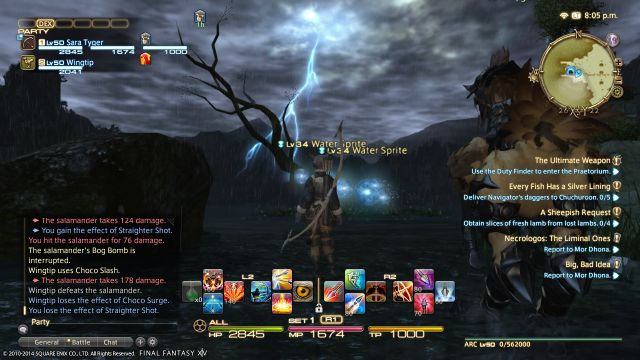
In addition to what’s already available, Square-Enix provides content patches every month for free, so there’s always something new to do. Approximately once per season, a major content patch is released which includes new dungeons and loads of new quests. In between these larger patches, smaller content patches are released which improve the quality of life of the game’s players. For example, if I was riding my chocobo to go on a treasure hunt, I never used to be able to check my treasure map unless I dismounted. One of the patches changed it so that now I can check it while riding. That might not seem like much, but it eliminated needless complication and it makes sense that if someone can do that in real life while on a horse, an Eorzean should be able to do that on a chocobo. The quality of life improvements show that Square-Enix does listen to their fans (although listening to their fans too much has been shown to have consequences, so they should be careful which fan feedback they take).
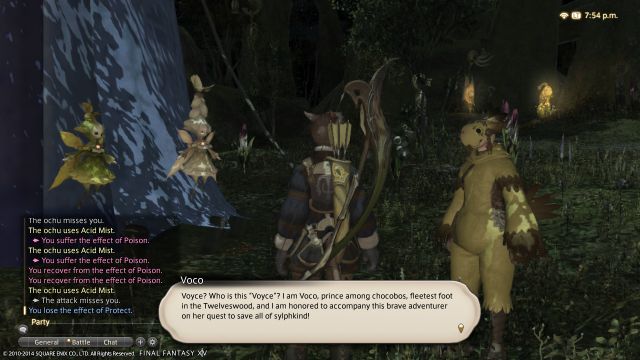
If you want to play this game, I would probably advise that you get a PlayStation 4 or buy it for your PC. The PlayStation 3 is generally capable of running this game, but if too many people gather in one location, it can slow things down or cause certain elements to not load. In Frontline, one of the two PvP games available, 72 players are all on the map at once, so the initial rush to claim territory sometimes causes enemy players to not show up on the screen right away on the PS3. In the long run that doesn’t matter, but opponents are sometimes able to get a couple hits in before a PS3 user can see them and fight back. During the fight against Odin, the sheer number of players who gather to help bring him down can sometimes keep Odin from loading on a PS3 until about two or three minutes have passed, and given the limited time the fight is available each time it spawns and the absurdly high amount of HP he has, those few minutes are sometimes the difference between victory or failure. Also, if you’re playing a healing class, you can’t heal party members that the PS3 doesn’t load up. Hunts work the same way: often there’ll be so many people gathered that the hunt mark itself won’t show up on a PS3 system for a minute or two, thus some PS3 users are unable to participate in hunts during peak hours. One of my friends (who uses an early model PS3) was forced to quit a 24-man dungeon because his system was having trouble loading all of it.
However, despite these small issues, I’ll recommend even the PS3 version if that’s all you have access to. If you’re a fan of MMO games, this one is one of the best on the market. It’s managed to get me to play in an on-line multiplayer setting, so it has to be something special.



